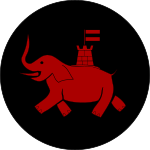| Ninth Army | |
|---|---|
 9th Army formation badge. | |
| Active | 1941–1945 |
| Country | |
| Branch | |
| Type | Field army |
| Part of | Middle East Command |
| Engagements | Second World War |
The Ninth Army was a field army formation of the British Army during the Second World War, formed on 1 November 1941 by the renaming of Headquarters, British Troops Palestine and Transjordan. [1] The Ninth Army controlled British and Commonwealth land forces stationed in the eastern Mediterranean. [2]